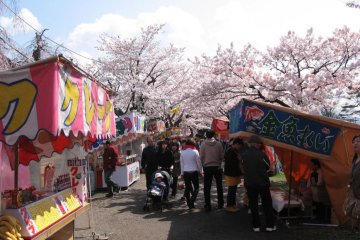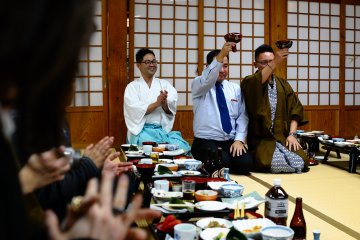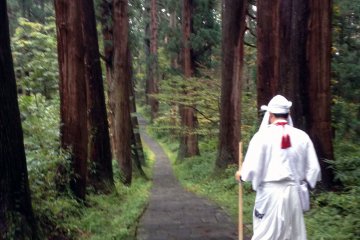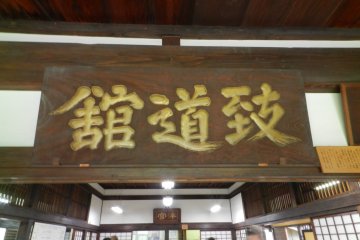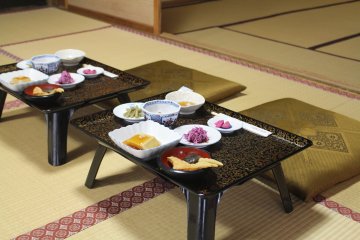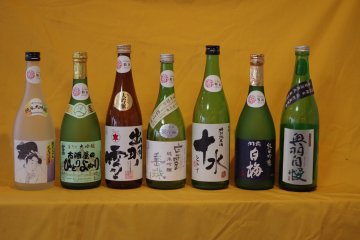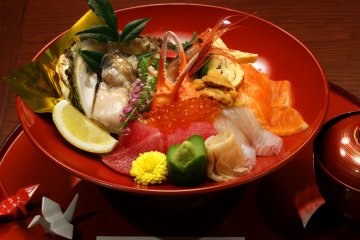Designated a UNESCO Creative City of Gastronomy in 2014, Tsuruoka is blessed with a diverse food culture thanks to the nature’s bounties brought by an ideal environment and irrigation in the Shônai region.
Thanks to local cuisine such as the local vegetarian Shôjin Ryôri favoured by the Yamabushi at Dewa Sanzan and the living cultural assets of almost 50 types of heirloom vegetables passed down through the generations, Tsuruoka’s UNESCO Creative Cities Network (UCCN) membership in the field of gastronomy is thanks to how its unique, singular food culture has evolved and survived in parallel with other cultural assets, such as Kurokawa Noh and Dewa Sanzan’s mountain area.
Local foods
Explore some of Tsuruoka’s best-loved local foods.
Sushi and Fish
Yamagata is famed for some of the best fish in Japan as it faces the Sea of Japan. Sawara, the Japanese mackerel, is considered a top-brand of seafood, caught off the Shônai coast. Amaebi, a kind of sweet shrimp caught in the region makes very soft and melt-in-the-mouth sushi. Tsuruoka’s rocky seas also provide fresh oysters that are absolutely divine on sushi.

Dadachamame
This local edamame (soybean) variety is said to be the most delicious in Japan, thanks to its unique flavour, sweetness and aroma.

Gomadôfu
Gomadôfu, the sesame-flavored tofu, is a local handmade dish which consists of crushed sesame tofu and an ankake sauce on top of it (potato starch based sauce). It is always included in shôjin ryôri and thus is very appreciated by vegetarian gourmets.

Top Restaurants
Stop by one of these restaurants to discover the best of Tsuruoka’s unique and local cuisine.
Hagurosan Saikan (Shoujin Ryori)
Attempting the full three sacred mountain pilgrimage at Dewa Sanzan can involve quite a journey, so many visitors schedule in a stop at a ryokan along the route, such as Saikan on Mt Haguro. Here you can try authentic Shojin Ryori – a sophisticated cuisine prepared by Buddhist monks. It is based on soybean-based foods (like tofu), comprising seasonal vegetables and mountain plants from the local Dewa Sanzan area too. Made without any animal products, it is suitable for vegetarians too.

Foodever
Opened in July 2017, Foodever is a food culture market dedicated to showcasing Tsuruoka's proud culinary heritage and cultural gastronomy award. The facility invites visitors to learn, experience and taste Tsuruoka's culinary culture. At Foodever, you can enjoy local Tsuruoka delicacies made by specialist chefs, as well as many more flavours at the food court, comprising Tsuruoka Bar (of local delicacies), a sushi restaurant, a Spanish-style bar and wine/sake bar.

Shinchaya (新茶屋)
Shinchaya teahouse provides a beautiful Edo period setting, complete with traditional Japanese garden. Visitors can try from a selection of traditional Japanese cuisine – with the focus on local Tsuruoka flavours and recipes, and seasonal foods from the Shonai area.

Gourmet Events
Tsuruoka throws several unique events to match its proud Creative City of Gastronomy status. Here we introduce some of the best Winter events in the calendar:
Sea of Japan Kandara Festival
Every January, almost 20,000 people visit this local festival in Tsuruoka’s Nakamachi to try the local dongara-jiru, a seasonal soup made from black cod and popular in the Shonai area. Multiple shops serve their own local dongara-jiru variety, with other stalls showcasing their products and souvenirs from around the Tohoku and Niigata areas.

Oyama Shinshu Sake Brewery Festival
Every February sees 4 sake breweries (Haneda, Dewanoyuki, Fuji and Kato) in the Oyama area of Tsuruoka open their sake brewery doors to visitors hoping to imbibe the latest batches of sake on offer at each brewery. These include Food stalls ensure there is plenty to eat too for those making the trip.

Souvenirs
Grab something to take home from the vast number of unique Tsuruoka souvenirs. Here we introduce a small selection of local souvenir ideas:
Gassan Wine
Gassan wine is a popular local souvenir, made from crimson glory vine grown by local farmers, helped by the pure water emanating from the sacred Mount Gassan area, one of the Dewa Sanzan mountains. An annual festival sees visitors flock to Tsuruoka each September to celebrate this local drink.

Kokyo (古鏡)
This Japanese traditional sweet is crispy on the outside but soft in the middle, based on the gyuhi-style of mochi (glutinous rice) and comprising a specially-made sweet bean paste mastered by the Kimura-ya confectioner and resembling the shape of an old mirror, inspired by the Kagamiike shrine/pond area at Mt Haguro.

Japanese Sake
The rice cultivated in Shônai region has been proven to contain more umami taste than any other kind of rice by Keio University in 2014. Hence, the sake brewed from this rice is taste-rich and has a particular aftertaste that will delight any sake enthusiast.




